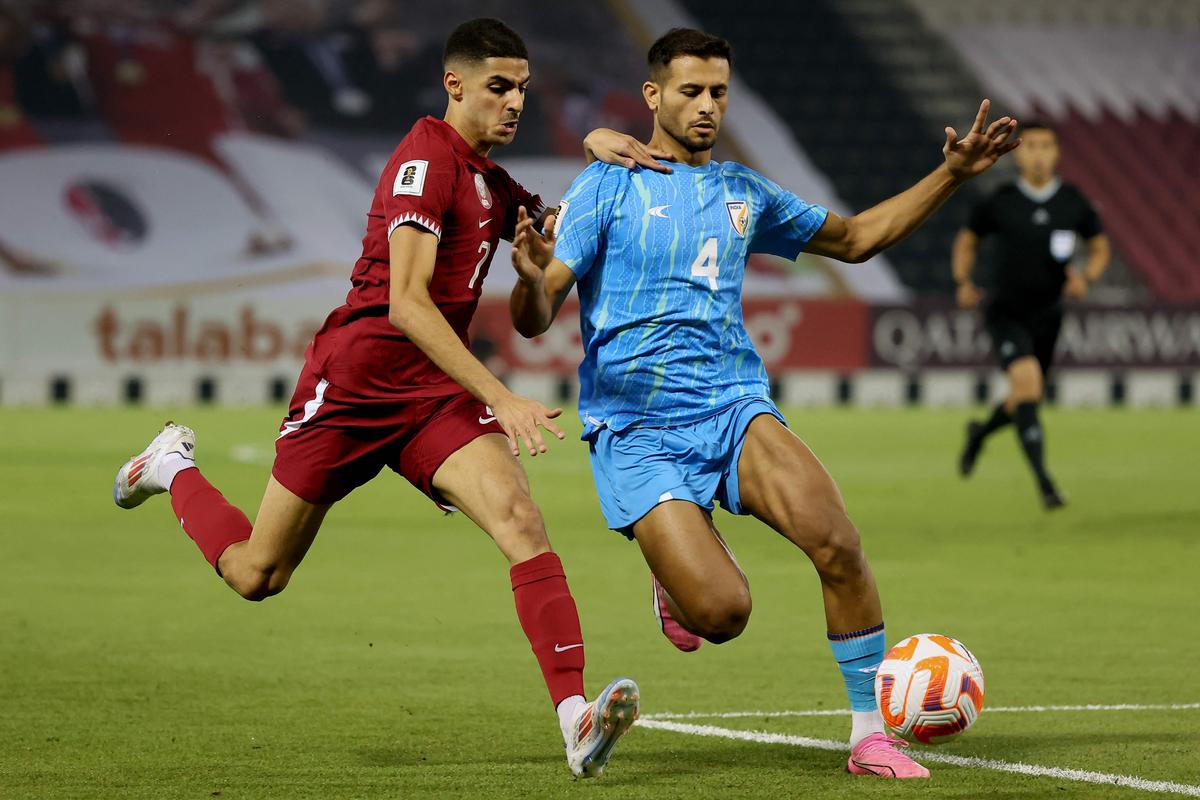Early blossom, Chhetri retirement and a controversial goal: Only agony for India as it bites the dust in FIFA World Cup qualifiers
In the end, it finished with tears, dejected faces and a complaining coach – where have we seen this before? Indian football, in this case, the trajectory of the men’s football team, under Igor Stimac, has followed a similar path in the last year.
A zero-goal and zero-point campaign in the AFC Asian Cup, for the first time, a loss to Afghanistan on home soil – also for the first time – was followed by a controversial 1-2 loss to Qatar as India’s dreams of qualifying for the FIFA World Cup came to an agonising end at the Jassim bin Hamad Stadium in Doha on Tuesday.
ALSO READ | FIFA World Cup 2026 Qualifiers points table
How did the qualification campaign pan out?
India started its second round of qualification on a high, with a 1-0 win against Kuwait, its first win on foreign soil in two decades.
Manvir Singh and Lallianzuala Chhangte combined in a counterattack with the Mumbai City forward setting up Manvir in front of the goal.
But India’s form plummeted since, with a 0-3 battering to Qatar, followed by the Asian Cup. It drew goalless against Afghanistan and then lost to the same side, with fans demanding the ouster of Stimac.
On thin ice, India started its next game against Kuwait – Sunil Chhetri’s last game for India – looking for a silver lining. Despite having more shots (15 to 13), ‘slow passing’ by the Blue Tigers failed to break the deadlock.

FILE PHOTO: Sunil Chhetri during his last match for India against Kuwait in the FIFA Qualifier at the Salt Lake Stadium at Kolkata.
| Photo Credit:
MOORTHY RV/ The Hindu
FILE PHOTO: Sunil Chhetri during his last match for India against Kuwait in the FIFA Qualifier at the Salt Lake Stadium at Kolkata.
| Photo Credit:
MOORTHY RV/ The Hindu
“It took us some time to gear up, to start passing the ball and moving into areas where we could create danger. I would say that the general passing speed was the biggest problem we had. That was not good enough to break down a team like Kuwait,” Stimac said after the match.
“Even in the situations where we had certain moments when we put pressure on them and continuous attacks, there was no quality in the delivery to hurt them more,” Stimac said.
ALSO READ | AIFF at Stimac’s mercy over his future after handing contract till 2026
The next and final barrier remained Qatar, which had humiliated India on its own turf, last year. The Blue Tigers started the match well, with captain Gurpreet Singh Sandhu making a good save off a set piece early on.
In the 37th minute, Brandon Fernandes’ pass, after a major deflection, fell to Lallianzuala Chhangte, who struck it home. A win would have secured India’s spot in the Asian Cup and, after that goal, it looked like a serious possibility.
In the second half, however, a controversial goal in the 73rd minute, and a long-ranger, 12 minutes later, distinguished any flicker of hope for the travelling side.
Key Takeaways
While there were plenty of impediments that went against the Blue Tigers, Stimac and India will now have time to look back at the six qualifying games and figure out the whats instead of the what-ifs to plan its last-ditch attempt to qualify for the next edition of the Asian Cup through the third round.
India, under Stimac, has played more through short passes than under former coach Stephen Constantine, who had a penchant for long-ball football.
The Blue Tigers have started building from the back, with quick passing, from Anwar Ali to Jeakson Singh (or Lalengmawia Ralte) and the No. 10 – either Brandon Fernandes or Sahal Abdul Samad – carrying the ball to pull off overlaps.

Qatar’s forward Mohamed Gouda and India’s defender Anwar Ali vie for the ball.
| Photo Credit:
AFP
Qatar’s forward Mohamed Gouda and India’s defender Anwar Ali vie for the ball.
| Photo Credit:
AFP
Though the tactic looks seamlessly brilliant when executed to perfection, the risk of losing the ball increases in case of mis-passes – which can be prevented by team chemistry alone.
That, in turn, can only improve if the team spends more time together.
The Golden Generation of Spain had an extremely hard-to-breakdown midfield in 2010 because the core of the team (six of the regular starting 11) played for one team, Barcelona, for most of the year.
That team became one of the best proponents of the play-from-the-back brand of football in 2010, eventually winning its first-ever FIFA World Cup.
In India’s most immediate match, the most players from one club in the starting 11 were three – Chhangte, Mehtab Singh and Rahul Bheke – who played for Mumbai City FC.
Positionally, that number falls to two, Mehtab and Bheke at the back, which indicates that the national team players need to spend more time together, be it club football, which does not hold true in the current scenario, or in the national camp.
Stimac has been one of the most vocal advocates for a longer national camp, which, if he stays in charge for long, can work in both his and his boys’ favour in the long run.
Beginning of a new era
India’s FIFA World Cup campaign, as a team, witnessed a subtle change in guard in several positions, primarily, the centre-back and the striker.
Sandesh Jhingan, 30, India’s mainstay as centre-back, was ruled out of the season after an injury in the AFC Asian Cup while Rahul Bheke, at 33, is past his prime.
India’s Mehtab Singh in action against Qatar.
| Photo Credit:
Reuters
India’s Mehtab Singh in action against Qatar.
| Photo Credit:
Reuters
Mehtab, 26, and Anwar, 23, have looked sharp, with the latter deployed as a ball-playing defender and the former playing a more defensive role.
At the left-back position, Subhasish Bose (28) now faces competition from Akash Mishra and Jay Gupta, both of whom are 22 years old, giving Stimac enough options to shuffle his cards at the back.
But the biggest hole would be the absence of Chhetri, who, despite being past his prime in the last few years, caused trouble in the opposition box with his off-the-ball movement.
Chhetri’s movement released Manvir against Kuwait in the build-up of the goal and that is something India’s new No. 11, Rahim Ali would need to learn, as a potential striker, alongside Manvir.



